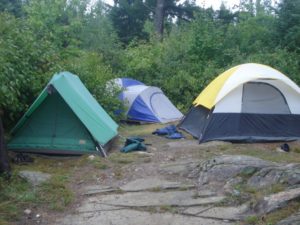Shelter
Intro
Look for tent pads that are set back and sheltered. Use the available spots if at all possible; do not hack out a new area for your tent. Pick a spot with the fewest rocks and roots and check overhead for widow makers. Widow makers are dead trees or branches that have the potential to fall, or those that have already fallen and are leaning against another tree. A strong wind may bring them down.
When it comes time to pound in your stakes, don’t be surprised if they don’t go in. You can put a stake or a stick sideways through the tent loop and weight down the ends with rocks. Most tents will be fine without all the stakes in.
- Tents
- Tarps
Tents
Today’s tents are mostly made from nylon with the dome style being the most popular, though many still swear by the classic A-frame. Dome tents are comprised of two or more folding flexible poles that attach at the corners of the tent and cross over in the middle providing support. Tents vary in size and weight. You will want one that is sturdy enough to survive wind and driving rain. Remember this is your primary shelter when the weather turns bad. If you buy a tent, be sure the rainfly covers the tent against blowing rain. Shorter rainflies will allow the rain to blow up and in the tent. Zippers leak. The rainfly should protect zippered openings. We add an extra ground tarp to keep ground moisture and dirt off the tent bottom and away from us. If you use a ground tarp, be sure it is smaller than your tent’s footprint or run off from the tent will collect between the ground tarp and the tent floor.
Dome Tents
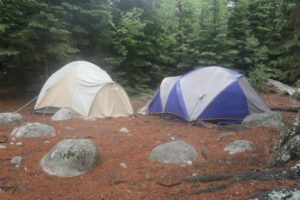
When you buy a tent, always figure they sleep one less than advertised. A two-person tent is actually a solo tent, and a three-person will fit two. A five-person tent (that fits four) is the biggest you will want to use. The bulk and weight of larger tents make them hard to pack.
A-Frame Tent
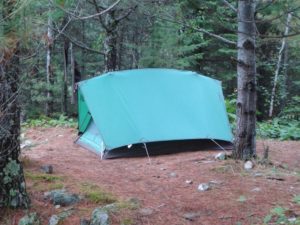
Every year treat the zippers to wax or silicone to ease their operation, and every couple of years, apply silicone water repellant to the outside of the tent and the rainfly. I also recommend using the lighter-weight aluminum tent stakes as opposed to the heavier steel stakes or the bulky plastic stakes.
Bivy Sacks, Solo Tents, and Hammocks
If you are a soloist, love the open concept, or just don’t like sleeping with other people; you may want to use a bivy sack, solo tent, or hammock. A bivy is basically a cocoon that you place your sleeping bag in. It has a raised area around your head with netting and a rain fly to keep the bugs and rain away. A solo tent is a smaller tent that is just large enough to fit your sleeping bag and a small pack.
A hammock is nice in that it gets you off of the ground. The drawback is you need trees, not available at some sites. Even in the middle of a forest, you may find it hard to locate two sturdy trees the right distance apart. This is especially true if you are traveling in a burnout area. If you do decide to use a hammock, be sure it has netting and a rainfly. It is also a good idea to get one that can be set up on the ground.
Tarp
You will want to bring a tarp along as a rainfly or windbreak. Not every evening is going to be calm and clear. There are different ways to deploy this tarp depending on your situation. We use a twelve-foot-by-twelve-foot green/brown tarp with ten feet of cord attached on each corner and four stakes rolled inside. We also carry fifty feet of quarter-inch cord to suspend the tarp, if needed.
There are numerous ways to hang the tarp depending on what’s available.
As a rainfly you can:
Suspend the tarp by tying the four corners to four trees.
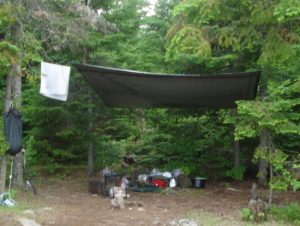
Suspend the tarp by tying two corners to two trees and use paddles for the other two corners.
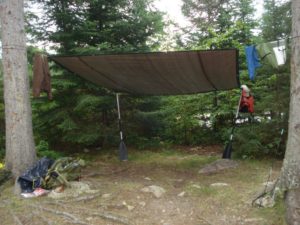
In a treeless area you can use four paddles.
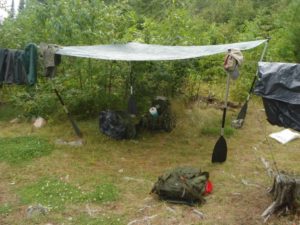
Stake or tie down the two back corners and tie the front corners to two trees or use paddles.
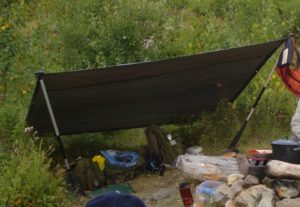
You can string a cord between two trees and drape the tarp over it. Use paddles on the four corners.
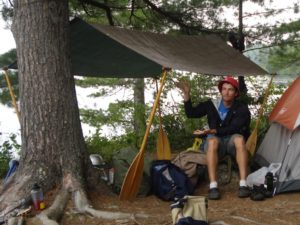
As a wind break you can:
Tie the tarp vertically between two trees. Much like a sail.
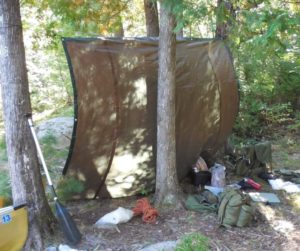
Use a tree as a center post. Place the middle of the tarp against the tree. Fan out the sides. Stake out the bottom corners. Tie the top corners to trees or use paddles.
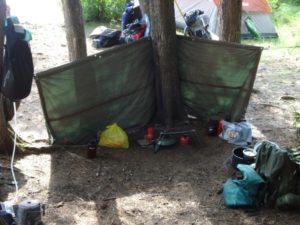
Stake or tie down the two front corners. Tie the two back corners to two trees or use paddles
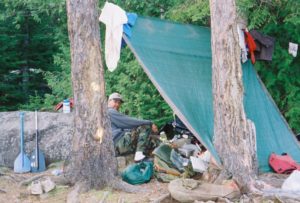
As a combination rain fly and wind break you can:
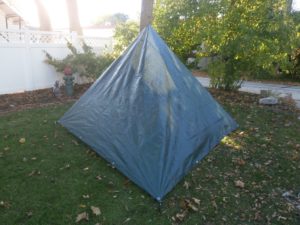
Tie one corner to a tree or branch. Stake out the other three corners. It also works as a survival tent.

